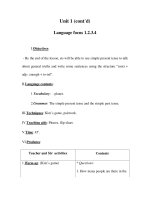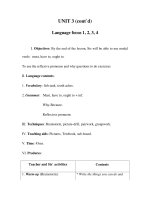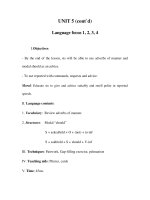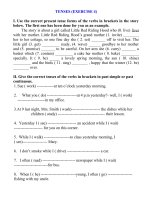3 4 1 where does that come from
Bạn đang xem bản rút gọn của tài liệu. Xem và tải ngay bản đầy đủ của tài liệu tại đây (2.65 MB, 10 trang )
Fascinating Facts
• Most Americans use nearly seven hundred
pounds of paper each year.
• Thirty-nine percent of things put in
landfills are made of paper and could have
been recycled.
• It takes between five hundred and one
thousand years for just one inch of rich
soil to form.
Genre
Nonfiction
Comprehension Skill
Draw Conclusions
Text Features
•
•
•
•
Captions
Headings/Subheadings
Map
Time Line
Scott Foresman Social Studies
ISBN 0-328-14828-8
ì<(sk$m)=beici < +^-Ä-U-Ä-U
by Barbara Bigelow
In this book you will read about natural
resources. Natural resources come from the
earth. Different parts of the United States
have different resources.
Vocabulary
natural resources
Write to It!
Look around the room. What things come
from natural resources? Write two or
three sentences about your ideas.
Write your sentences on a separate sheet
of paper.
region
physical environment
landform
climate
fuel
mineral
communities
Illustration
3 ©Guy Porfirio
Photographs
Every effort has been made to secure permission and provide appropriate credit for photographic material. The publisher deeply
regrets any omission and pledges to correct errors called to its attention in subsequent editions.
by Barbara Bigelow
Unless otherwise acknowledged, all photographs are the property of Scott Foresman, a division of Pearson Education.
Photo locators denoted as follows: Top (T), Center (C), Bottom (B), Left (L), Right (R) Background (Bkgd)
ISBN: 0-328-14828-8
Copyright © Pearson Education, Inc.
All Rights Reserved. Printed in the United States of America. This publication is protected
by Copyright, and permission should be obtained from the publisher prior to any prohibited
reproduction, storage in a retrieval system, or transmission in any form by any means,
electronic, mechanical, photocopying, recording, or likewise. For information regarding
permission(s), write to: Permissions Department, Scott Foresman, 1900 East Lake Avenue,
Glenview, Illinois 60025.
1 2 3 4 5 6 7 8 9 10 V0G1 14 13 12 11 10 09 08 07 06 05
Opener: (C) ©Royalty-Free/Corbis, (T Bkgd) ©Getty Royalty Free, (B Bkgd) ©Getty Royalty Free
2 ©Wendell Metzen/Index Stock Imagery
4 ©David Muench/Corbis
5 ©Royalty-Free/Corbis
6 ©Getty Images
7 ©Corbis
8 ©Peter Adams/Getty Images
Editorial Offices: Glenview, Illinois • Parsippany, New Jersey • New York, New York
9 ©David R. Frazier Photolibrary, Inc./Alamy Images
10 ©Gary Vestal/Getty Images
Sales Offices: Needham, Massachusetts • Duluth, Georgia • Glenview, Illinois
11 ©Tom Myers
Coppell, Texas • Sacramento, California • Mesa, Arizona
13 ©The Granger Collection, NY
14 ©G.Brad Lewis/Photo Researchers, Inc.
The regions of the United States are named
for their locations on the map. This map shows
the regions of the United States.
West region
Sand is a natural resource.
Northeast region
Midwest region
Southwest region
Southeast region
Every region has resources.
Look around you. Just about everything
you see started out as a natural resource.
Natural resources are useful things that come
from the Earth.
The paper in this book came from a tree. Our
forests and trees are natural resources.
2
3
That is a big one!
The United States is a very big country. It is
divided into different regions. A region is a
large area of land.
The regions of the United States have very
different physical environments. You can tell
one type of physical environment from another
by looking at its landforms and its climate.
This is a desert region with a hot climate.
This is a mountain region with a cool climate.
Some places in our country are hot, dry, and
flat. Others are cool, hilly, and rocky. Still others
have thick forests and green grass.
4
5
Compass Rose
Texas is a state in the Southwest. It is famous
for its oil. Oil is a natural resource found
underground. We use oil for fuel. Fuels provide
us with heat and light.
Oil wells are dug underground to
reach the oil.
Did that really come
from Earth?
The different regions of the United States have
very different resources. Each region is made
of several states. Let’s look at a few states and
their resources.
6
The state of Wisconsin is in the Midwest.
This state has lots of cows, farmland, and
trees. Wisconsin is known for things such as
milk and cheese. This state also makes paper.
Look at the potatoes the next time you
are at the grocery store. Some of them
are probably from Idaho.
Farmers use natural resources to raise animals.
Idaho is a state in the Northwest.
Much of its land is used for farming. Idaho is
famous for its potato crops.
9
What is that shiny yellow stuff?
Gold is a very valuable mineral. Gold was
discovered in the Southwest region in California
in 1848. Thousands of people moved west after
gold was discovered.
Our forests will be around for a long time if we are careful.
Keep on planting!
Forests are a natural resource. People can
help make sure we do not run out of trees.
When a tree is cut down, another one can be
planted in its place.
That came from a tree?
Furniture and paper are not the only things
made from trees. Some medicines, football
helmets, paints, cough drops, and gum also
come from trees.
10
Gold is a shiny yellow mineral.
11
How did they get to the gold?
Gold is usually found in rock or mixed with
soil. Miners panned for gold. They swirled
water from streams in pans to separate the tiny
pieces of gold from the dirt.
Later, people dug deep holes in the earth
called mines. They searched for larger chunks of
gold.
Then what happened?
Not many miners got rich. By 1850 a lot of
people decided to head home.
Some people ended up staying in the West.
Many became farmers. Communities were
formed. In 1850 California became our country’s
thirty-first state.
Miners panned for gold.
12
Hybrid Cars
Hybrid cars use two different types of
power. Hybrid cars run on gas and they run on
electricity. These cars use less gas than regular
cars.
Can our natural resources
run out?
Oil, coal, and natural gas were formed
millions of years ago. These resources are used
for energy.
Once we use up all the oil, coal, and natural
gas these natural resources will be gone forever.
By learning about resources, you also learn how
you can help Earth.
Hybrid cars keep the air
cleaner.
A Fuel Time Line
1839
1973
The first steam shovel
is invented. This
invention makes it much
easier to dig coal from
the ground.
The price of oil goes up in
the United States. People
have to wait in lines for
hours at gas stations.
1839
1930s
Lots of oil is found
in Texas.
1859
14
1930s
1973
2004
Scientists predict
that plankton,
sunflowers, and
bananas may be the
fuels of the future.
1997
2004
1859
1997
America’s first oil field is
drilled in Pennsylvania.
The gas-electric hybrid car is
introduced in Japan.
15
Glossary
In this book you will read about natural
climate
kind resources
of weather
a place
resources. the
Natural
come
fromhas
the
fromDifferent
year to year
earth.
parts of the United States
have different resources.
communities
places where people live,
work, and have fun together
fuel a resource Vocabulary
that can be used to produce
natural
resources
light, heat, or
other forms
of energy
region
landform a shape or part of the Earth’s
physical environment
surface, such as a mountain or a desert
landform
mineral a natural resource that has never
climate
been alive
fuel
natural resources
useful things that come
mineral
from the Earthcommunities
Write to It!
Look around the room. What things come
from natural resources? Write two or
three sentences about your ideas.
Write your sentences on a separate sheet
of paper.
Illustration
3 ©Guy Porfirio
physical environment a region’s
landforms and climate
Photographs
Every effort has been made to secure permission and provide appropriate credit for photographic material. The publisher deeply
regrets any omission and pledges to correct errors called to its attention in subsequent editions.
Unless otherwise acknowledged, all photographs are the property of Scott Foresman, a division of Pearson Education.
region a large area of land with special
ISBN: 0-328-14828-8
features
Copyright © Pearson Education, Inc.
All Rights Reserved. Printed in the United States of America. This publication is protected
by Copyright, and permission should be obtained from the publisher prior to any prohibited
reproduction, storage in a retrieval system, or transmission in any form by any means,
electronic, mechanical, photocopying, recording, or likewise. For information regarding
permission(s), write to: Permissions Department, Scott Foresman, 1900 East Lake Avenue,
Glenview, Illinois 60025.
1 2 3 4 5 6 7 8 9 10 V0G1 14 13 12 11 10 09 08 07 06 05
16
Photo locators denoted as follows: Top (T), Center (C), Bottom (B), Left (L), Right (R) Background (Bkgd)
Opener: (C) ©Royalty-Free/Corbis, (T Bkgd) ©Getty Royalty Free, (B Bkgd) ©Getty Royalty Free
2 ©Wendell Metzen/Index Stock Imagery
4 ©David Muench/Corbis
5 ©Royalty-Free/Corbis
6 ©Getty Images
7 ©Corbis
8 ©Peter Adams/Getty Images
9 ©David R. Frazier Photolibrary, Inc./Alamy Images
10 ©Gary Vestal/Getty Images
11 ©Tom Myers
13 ©The Granger Collection, NY
14 ©G.Brad Lewis/Photo Researchers, Inc.









